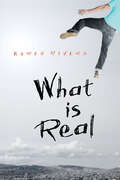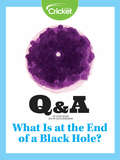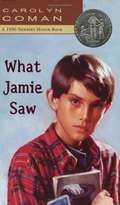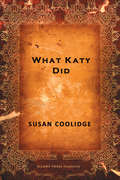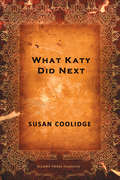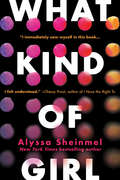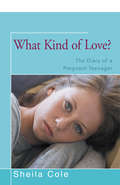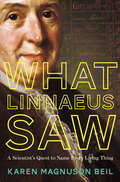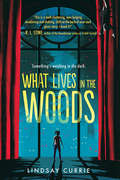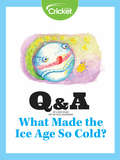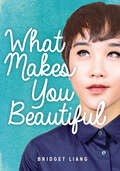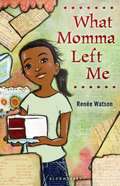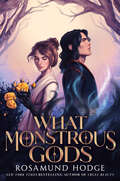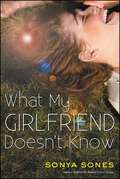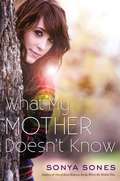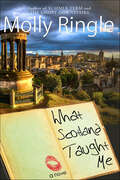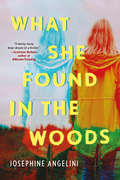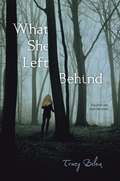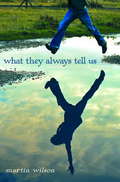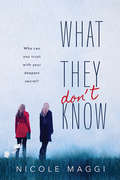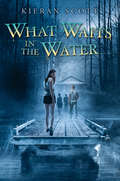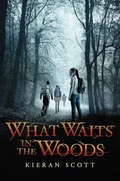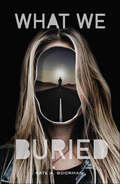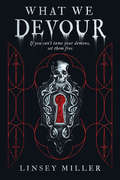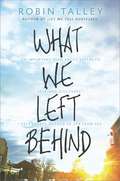- Table View
- List View
What Is Real
by Karen RiversDex Pratt’s life has been turned upside down. His parents have divorced and his mother has remarried. When his father attempts suicide and fails, Dex returns to their small town to care for him. But he’s not prepared for how much everything has changed. Gone are the nice house, new cars, fancy bikes and other toys. Now he and his wheelchair-bound dad live in a rotting rented house at the back of a cornfield. And, worse, his father has given up defending marijuana growers in his law practice and has become one himself. Unable to cope, Dex begins smoking himself into a state of surrealism. He begins to lose touch with what is real and what he is imagining. And then there are the aliens...and the girl-of-his-dreams...and the crop circle...
What Is at the End of a Black Hole?
by Lizzie WadeWho knows what is at the end of a black hole? Astrophysicists!
What Jamie Saw
by Carolyn ComanJamie’s mother is there to catch the baby —this time. She does what she must to keep her family out of harm’s way, but still the shock waves of Van’s act reverberate through their lives. What Jamie Saw is a moving, visceral dramatization of violence in the home, told not from the point of view of a victim, but as witnessed by a nine-year-old boy. The impact of observed violence perpetrated against loved ones is profound and destructive, and altogether too common. Drawing on his mother’s desperate strength, his own determination, and help from an unexpected friend, Jamie confronts his fear and anxiety -- learning, adapting, and triumphing. <P><P> A Newbery Honor Book.
What Katy Did
by Susan CoolidgeKaty Carr Book 1: Katy Carr's big dreams and desire for adventure are at odds with what is expected of her by her widowed father and the family's caregiver, Aunt Izzie. As a twelve-year-old girl, she is expected to help in the household and to set an example for her brothers and sisters, something that the mischievous Katy finds nearly impossible to do. But when her disobedience results in a terrible accident, Katy finds herself confined to her bed. Frustrated and at odds with her family, Katy must learn to make the best of things or risk driving her family away just when she needs them the most.
What Katy Did Next
by Susan CoolidgeKaty Carr Book 3: The irrepressible Katy Carr returns in the third novel in Susan Coolidge's charming series. Presented with the chance to travel abroad as the companion to her dear friend, Amy, Katy is initially reluctant to accept the invitation, but is soon persuaded to change her mind. Over the course of the tour, Katy experiences the culture of Europe and finds herself falling in love most unexpectedly.
What Kind of Girl
by Alyssa SheinmelWhat kind of girl stays after her boyfriend hits her? <P><P>The girls at North Bay Academy are taking sides. It all started when Mike Parker's girlfriend showed up with a bruise on her face. Or, more specifically, when she walked into the principal's office and said Mike hit her. But her classmates have questions. Why did she go to the principal and not the police? Why did she stay so long if Mike was hurting her? Obviously, if it's true, Mike should be expelled. But is it true? <P><P>Some girls want to rally for his expulsion—and some want to rally around Mike. The only thing that the entire student body can agree on? Someone is lying. And the truth has to come out.
What Kind of Love?: The Diary of a Pregnant Teenager
by Sheila ColeIn a flash, Valerie's world comes tumbling down. She and Peter were sharing their dreams. Now she and Peter share a problem . . . Except it turns out to be Val's problem. Peter says he loves her, but he has to get on with his life. Valerie wishes she could get on with her life. But she lives each day with the reality Peter wants to forget--and it is she who must make the impossible choices . . . when love has no answers.
What Linnaeus Saw: A Scientist And His Quest To Name And Catalog Every Living Thing
by Karen Magnuson BeilThe globetrotting naturalists of the eighteenth century were the geeks of their day: innovators and explorers who lived at the intersection of science and commerce. Foremost among them was Carl Linnaeus, a radical thinker who revolutionized biology. In What Linnaeus Saw, Karen Magnuson Beil chronicles Linnaeus’s life and career in readable, relatable prose. As a boy, Linnaeus hated school and had little interest in taking up the religious profession his family had chosen. Though he struggled through Latin and theology classes, Linnaeus was an avid student of the natural world and explored the school’s gardens and woods, transfixed by the properties of different plants. At twenty-five, on a solo expedition to the Scandinavian Mountains, Linnaeus documented and described dozens of new species. As a medical student in Holland, he moved among leading scientific thinkers and had access to the best collections of plants and animals in Europe. What Linnaeus found was a world with no consistent system for describing and naming living things—a situation he methodically set about changing. The Linnaean system for classifying plants and animals, developed and refined over the course of his life, is the foundation of modern scientific taxonomy, and inspired and guided generations of scientists. What Linnaeus Saw is rich with biographical anecdotes—from his attempt to identify a mysterious animal given him by the king to successfully growing a rare and exotic banana plant in Amsterdam to debunking stories of dragons and phoenixes. Thoroughly researched and generously illustrated, it offers a vivid and insightful glimpse into the life of one of modern science’s founding thinkers.
What Lives in the Woods
by Lindsay CurrieFor fans of Small Spaces and the Goosebumps series by R.L Stine comes a chilling ghost story about a girl living in the decrepit and creepy mansion, who discovers something in the woods is after her, from the New York Times bestselling author of Scritch Scratch and The Mystery of Locked Rooms. All Ginny Anderson wants from her summer is to sleep in, attend a mystery writing workshop, and spend time with her best friend. But when Ginny's father—a respected restoration expert in Chicago—surprises the family with a month-long trip to Michigan, everything changes. They aren't staying in a hotel like most families would. No, they're staying in a mansion. A twenty-six room, century-old building surrounded by dense forest. Woodmoor Manor.But unfortunately, the mansion has more problems than a little peeling wallpaper. Locals claim the surrounding woods are inhabited by mutated creatures with glowing eyes. And some say campers routinely disappear in the woods, never to be seen again.As terrifying as it sounds, Ginny can't shake the feeling that there's something darker . . . another story she hasn't been told. When the creaky floors and shadowy corners of the mansion seem to take on a life of their own, Ginny uncovers the wildest mystery of all: There's more than one legend roaming Saugatuck, Michigan, and they definitely aren't after campers.It's after her."This is a teeth-chattering, eyes bulging, shuddering-and-shaking, chills-at-the-back-of-your-neck ghost story. I loved it!"—R.L. Stine, author of the Goosebumps series on Scritch ScratchPick up What Lives in the Woods if you are looking for:A book for middle school students, 5th grade to 9th gradeA story with a strong female protagonist that explores bravery, friendship, and familyMystery books for kids 9-12Chilling ghost stories and ghost books for kids (perfect for Halloween!)
What Made the Ice Age So Cold?
by Lizzie WadeWhat made the ice age so cold? This Q & A defines the different ice ages of the Earth and when they come about.
What Makes You Beautiful (Lorimer Real Love)
by Bridget LiangLogan knows he likes boys, but has not come out, and no one knows that he likes to sometimes wear girls' clothes and makeup. Then Logan starts at a school for the arts. There he meets Kyle, who is straight. Logan experiments with nail polish and more feminine clothes. Logan begins questioning his gender and decides to use they pronouns while trying to figure things out. Logan meets a classmate's mother, who is a transgender woman, and begins to come to terms with their gender identity. Realizing they are not a gay boy, but a transgender girl, Logan asks for people to call them Veronica. As a girl, does Veronica stand a chance with Kyle? Learn more in this moving high/low YA romance. Distributed in the U.S by Lerner Publishing Group
What Momma Left Me
by Renee WatsonWhat if your daddy did the worst thing in the world? And what if you were never going to see your momma again? How do you remake your life when you are only thirteen years old? * * * * * * * * Serenity knows she is good at keeping secrets, and she's got a whole lifetime's worth of them. Her momma is dead, her daddy's gone, and starting life over at her grandparents' house is strange. Luckily, certain things seem to hold promise: a new friend, a new church, a new school. But when her brother starts making poor choices, and her grandparents hold to a faith that Serenity isn't sure she understands, it is the power of love--in all its forms--that will repair her heart and keep her sure of just who she is. Renee Watson's talent shines in this powerful and ultimately uplifting first novel, celebrating one girl's gift for finding joy in the darkest times of life.
What Monstrous Gods
by Rosamund HodgeA rich and romantic new stand-alone fantasy loosely inspired by the classic Sleeping Beauty fairy tale, from the New York Times bestselling author of Cruel Beauty! Perfect for fans of These Violent Delights and The Shadow Queen. Centuries ago, the heretic sorcerer Ruven raised a deadly briar around Runakhia's palace, casting the royal family into an enchanted sleep—and silencing the kingdom's gods.Born with a miraculous gift, Lia's destiny is to kill Ruven and wake the royals. But when she succeeds, she finds her duty is not yet complete, for now she must marry into the royal family and forge a pact with a god—or die.To make matters even worse, Ruven's spirit is haunting her.As discord grows between the old and new guards, the queen sends Lia and Prince Araunn, her betrothed, on a pilgrimage to awaken the gods. But the old gods are more dangerous than Lia ever knew—and Ruven may offer her only hope of survival.As the two work together, Lia learns that they're more alike than she expected. And with tensions rising, Lia must choose between what she was raised to believe and what she knows is right—and between the prince she is bound to by duty...and the boy she killed.
What My Girlfriend Doesn't Know: One Of Those Hideous Books Where The Mother Dies; What My Mother Doesn't Know; What My Girlfriend Doesn't Know
by Sonya SonesA teen boy confronts the complications of love in this relatable free verse novel featuring a new cover and larger trim size.Don’t get me wrong—my girlfriend’s amazing. But the way things have been going lately, I’m starting to believe that the only thing worse than not getting what you want, is getting it. Picking up where What My Mother Doesn’t Know leaves off, this is the story of what happens next—told from the perspective of Murphy, Sophie’s new boyfriend. And even though Murphy’s thrilled to be with Sophie, the consequences of their relationship—and the temptations outside of it—force him to consider everything he knows about love. Told in free verse and brimming with authenticity, this novel provides unique insight into the mind of a young man.
What My Mother Doesn’t Know
by Sonya SonesComposed entirely of short poems in free verse, What My Mother Doesn't Know captures the ups and downs of Sophie's freshman year of high school and her first real romance.
What Scotland Taught Me: A Novel
by Molly RingleFresh out of high school, Eva Sonneborn is headed to Scotland with her best friends: scholarly, sarcastic Laurence; gorgeous, ghost-seeing Amber; and responsible, sweet Shannon. They plan to spend the next six months in Edinburgh, enjoying an adventure-filled work-abroad journey before parting ways for college. But when Eva meets Gil, a local bartender, she figures a little innocent flirting won't hurt her relationship with Tony, her ever-faithful boyfriend back home. But just when things turn less innocent with Gil, the trip starts throwing curveballs at not only her but her friends too. By the end of the trip, they've all fallen in love, sometimes with the wrong people - and with consequences that may tear their friendship apart forever... Molly Ringle's growing list of other successful titles include:The Chrysomelia Stories 1. Persephone's Orchard 2. Underworld's Daughter 3. Immortal's Spring The Goblins of Bellwater All the Better Part of Me Lava Red Feather Blue Sage and King
What She Found in the Woods
by Josephine AngeliniFor readers of psychological thriller books and wilderness survival stories, a gripping thriller about Magda who's desperate to get over a scandal at her New York private school. Fans of We Were Liars and A Good Girl's Guide to Murder will find themselves swept up in What She Found in the Woods!This is Magda's last chance. Recovering from a scandal at her elite New York City private school that threw life into a tailspin, she is shipped off to live with her grandparents in the Pacific Northwest for the summer.Medicated and uninspired, Magda spends her days in a fog wandering the forest behind the house. But then she stumbles upon Bo. He's wild and free, and he can see the real her. Magda starts believing she might be able to move on from her past and feel something again. But there's more to this sleepy town than she thought. And what Magda finds in the woods near Bo's forest home is the beginning of a whole new nightmare...Perfect for those looking for: Mental health books for teens An engaging mystery with an unreliable narrator Young adult thriller books A novel to keep you on your toes if a teen killer is out in the woods Suspense books
What She Left Behind
by Tracy BilenIn this suspenseful thriller, Sara and her mother are going to secretly escape her abusive father--when her mother mysteriously disappears.Sara and her mom have a plan to finally escape Sara's abusive father. But when her mom doesn't show up as expected, Sara's terrified. Her father says that she's on a business trip, but Sara knows he's lying. Her mom is missing--and her dad had something to do with it. With each day that passes, Sara's more on edge. Her friends know that something's wrong, but she won't endanger anyone else with her secret. And with her dad growing increasingly violent, Sara must figure out what happened to her mom before it's too late...for them both.
What They Always Tell Us
by Martin WilsonJAMES AND ALEX have barely anything in common anymore--least of all their experiences in high school, where James is a popular senior and Alex is suddenly an outcast. But at home, there is Henry, the precocious 10-year-old across the street, who eagerly befriends them both. And when Alex takes up running, there is James's friend Nathen, who unites the brothers in moving and unexpected ways.
What They Don't Know
by Nicole MaggiThree secrets. One decision. A friendship that will change everything.Mellie has always been the reliable friend, the good student, the doting daughter. But when an unspeakable act leads her to withdraw from everyone she loves, she is faced with a life-altering choice—a choice she must face alone.Lise stands up—and speaks out—for what she believes in. And when she notices Mellie acting strangely, she gets caught up in trying to save her...all while trying to protect her own secret. One that might be the key to helping Mellie.Told through Mellie and Lise's journal entries, this powerful, emotional novel chronicles Mellie's struggle to decide what is right for her and the unbreakable bond formed by the two girls on their journey.
What Waits in the Water
by Kieran ScottSTRANGER THINGS meets I KNOW WHAT YOU DID LAST SUMMER in our first YA ebook original, from Kieran Scott (author of the bestselling Private series, written as Kate Brian).Hannah is excited to spend some time at her best friend Jacob's lake house this summer. The catch? Hannah's annoying new stepsister, Katie, is tagging along. Katie is wild and pretty and seems to have a THING for Jacob. Hannah's not jealous...or is she? To make matters worse, the town they're staying in is sort of...creepy. And as Hannah gets to know some kids in the town, she learns there are all kinds of rumors swirling about the lake. Rumors about mysterious deaths and drownings. And monsters that may lurk below the deep. Hannah doesn't believe any of it...until she sees something horrific happen to a new friend. Did Hannah just witness a murder? Or was this a prank gone awry? And who can Hannah trust now? Master of suspense Kieran Scott spins a story full of twists and turns that will leave readers gasping and guessing until the very end.
What Waits in the Woods (Point Ser.)
by Kieran ScottSeeing things. You were just seeing things.For city girl Callie Velasquez, nothing sounds more terrifying than a night out in the wilderness. But, wanting to bond with her popular new friends, Lissa and Penelope, she agrees to join them on a camping trip. At least Callie's sweet new boyfriend, Jeremy, will be coming too. But nothing goes as planned. The group loses half their food supply. Then they lose their way. And with strange sounds all around her--the snap of a twig, a sinister laugh--Callie wonders if she's losing her mind. Tensions swirl among the group, with dark secrets suddenly revealed. And then, things take a fatal turn: Callie stumbles upon a cold dead body in the woods. Is the murderer close by, watching them? Callie has to figure out where she can turn and who she can trust, before her own life is at stake. Kieran Scott weaves a thrilling mystery that explores love, loyalty--and the dangerous decisions we make in order to survive.
What We Buried
by Kate A. BoormanTold from the split viewpoints of Liv and Jory, Kate A. Boorman's What We Buried is a psychological thrill ride that deftly explores how memories can lie, how time can bend, and how reconciling the truth can be a matter of life or death. “Do you ever just want to be believed?” Siblings Liv and Jory Brewer have grown up resenting each another. Liv—former pageant queen and reality TV star—was groomed for a life in the spotlight, while her older brother, Jory, born with a partial facial paralysis, was left in the shadows. The only thing they have in common is contempt for their parents.Now Liv is suing her mom and dad for emancipation, and Jory views the whole thing as yet another attention-getting spectacle. But on the day of the hearing, their parents mysteriously vanish, and the siblings are forced to work together. Liv feels certain she knows where they are and suspects that Jory knows more than he’s telling…which is true.What starts as a simple overnight road trip soon takes a turn for the dangerous and surreal. And as the duo speeds through the deserts of Nevada, brother and sister will unearth deep family secrets that force them to relive their pasts as they try to retain a grip on the present.
What We Devour
by Linsey MillerThe eat-the-rich, deliciously dark fantasy you've been waiting for. A girl with the power of the banished gods must bind herself to a wicked Prince to save her crumbling world, as the poor are sacrificed to save the rich. It's time for the wealthy to be devoured...Lorena Adler has a secret—she holds the power of the banished gods, the Noble and the Vile, inside her. But she has spent her entire life hiding from the world and her past. Lorena's content to spend her days as an undertaker in a small town, marry her best friend, Julian, and live an unfulfilling life so long as no one uncovers her true nature.But when the notoriously bloodthirsty and equally Vile crown prince comes to arrest Julian's father, he immediately recognizes Lorena for what she is. So, she makes a deal—a fair trial for her betrothed's father in exchange for her service to the crown.The prince is desperate for her help. He's spent years trying to repair the weakening Door that holds back the Vile...and he's losing the battle. As Lorena learns more about the Door and the horrifying price it takes to keep it closed, she'll have to embrace both parts of herself to survive.This heart-pounding YA story of magic and danger is perfect for readers looking for:Epic books for tweens and teensDazzling world-building and relatable charactersTween and teen LGBTQ+ booksHigh fantasy with asexual and aromantic representationFiction examining class structuresIntricate fantasy worldbuilding
What We Left Behind: An emotional young adult novel
by Robin TalleyFrom the critically acclaimed author of Lies We Tell Ourselves comes an emotional, empowering story of what happens when love may not be enough to conquer all Toni and Gretchen are the couple everyone envied in high school. When they separate for their first year at college-Toni to Harvard and Gretchen to NYU-they're sure they'll be fine. Where other long-distance relationships have fallen apart, theirs is bound to stay rock-solid. The reality of being apart, though, is very different than they expected. Toni, who identifies as genderqueer, meets a group of transgender upperclassmen and immediately finds a sense of belonging that has always been missing, but Gretchen struggles to remember who she is outside their relationship. As distance and Toni's shifting gender identity begin to wear on their relationship, the couple must decide-have they grown apart for good, or is love enough to keep them together?
